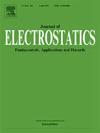Effect of high voltage and electrode configuration on the trajectories of metallic particles in roll-type electrostatic separators for granular mixtures
IF 1.9
4区 工程技术
Q3 ENGINEERING, ELECTRICAL & ELECTRONIC
引用次数: 0
Abstract
Electrostatic separation is a technique that uses electric field forces exerted on charged or polarized bodies for sorting the constituents of granular mixtures in various domains: minerals beneficiation, food processing, waste recycling, etc. In the case of the specific electrostatic separator that is the subject of this study, the electric field is generated between a rotating-roll electrode, connected to the ground, and a static electrode with inverted S profile connected to a high voltage (HV) supply. This paper is aimed at evaluating the effect of two factors: the high voltage applied between the two electrodes and the distance between them. A high-speed video camera was used to record the trajectories of mm-sized aluminum and copper particles. The visualization of these trajectories provided a better understanding of the dynamics of particles movement in the electric field of the separator. It enabled to adjust the applied high voltage and the inter-electrode distance to avoid the impacts between the fine aluminum particles and the static electrode, while driving the two types of metallic particles into different collecting compartments. The conclusions of the study will be implemented on a pilot-plant roll-type electrostatic separator integrated to the production line of an industrial recycler.
高压和电极结构对滚筒式静电分离器中金属颗粒运动轨迹的影响
静电分离是一种利用施加在带电或极化体上的电场力来分选颗粒混合物成分的技术,应用于矿物选矿、食品加工、废物回收等各个领域。对于作为本研究主题的特定静电分离器,电场是在连接到地面的旋转辊电极和连接到高压电源的倒S型静态电极之间产生的。本文旨在评估两个因素的影响:两个电极之间施加的高电压和它们之间的距离。高速摄像机被用来记录毫米大小的铝和铜颗粒的轨迹。这些轨迹的可视化可以更好地理解颗粒在分离器电场中的运动动力学。它可以调节施加的高压和电极间的距离,以避免细铝颗粒与静态电极之间的碰撞,同时将两种金属颗粒驱动到不同的收集室。这项研究的结论将在与一个工业回收厂的生产线结合的一个试验工厂辊式静电分离器上实施。
本文章由计算机程序翻译,如有差异,请以英文原文为准。
求助全文
约1分钟内获得全文
求助全文
来源期刊

Journal of Electrostatics
工程技术-工程:电子与电气
CiteScore
4.00
自引率
11.10%
发文量
81
审稿时长
49 days
期刊介绍:
The Journal of Electrostatics is the leading forum for publishing research findings that advance knowledge in the field of electrostatics. We invite submissions in the following areas:
Electrostatic charge separation processes.
Electrostatic manipulation of particles, droplets, and biological cells.
Electrostatically driven or controlled fluid flow.
Electrostatics in the gas phase.
 求助内容:
求助内容: 应助结果提醒方式:
应助结果提醒方式:


